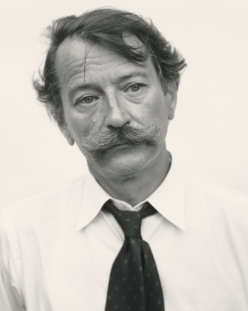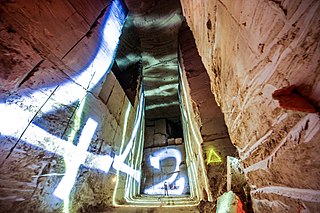
Ansel Easton Adams was an American landscape photographer and environmentalist known for his black-and-white images of the American West. He helped found Group f/64, an association of photographers advocating "pure" photography which favored sharp focus and the use of the full tonal range of a photograph. He and Fred Archer developed a system of image-making called the Zone System, a method of achieving a desired final print through a technical understanding of how the tonal range of an image is the result of choices made in exposure, negative development, and printing.

In photography and videography, multi-exposure HDR capture is a technique that creates high dynamic range (HDR) images by taking and combining multiple exposures of the same subject matter at different exposures. Combining multiple images in this way results in an image with a greater dynamic range than what would be possible by taking one single image. The technique can also be used to capture video by taking and combining multiple exposures for each frame of the video. The term "HDR" is used frequently to refer to the process of creating HDR images from multiple exposures. Many smartphones have an automated HDR feature that relies on computational imaging techniques to capture and combine multiple exposures.

An instant camera is a camera which uses self-developing film to create a chemically developed print shortly after taking the picture. Polaroid Corporation pioneered consumer-friendly instant cameras and film, and were followed by various other manufacturers.

Paul Strand was an American photographer and filmmaker who, along with fellow modernist photographers like Alfred Stieglitz and Edward Weston, helped establish photography as an art form in the 20th century. In 1936, he helped found the Photo League, a cooperative of photographers who banded together around a range of common social and creative causes. His diverse body of work, spanning six decades, covers numerous genres and subjects throughout the Americas, Europe, and Africa.

The Game Boy Camera, released as Pocket Camera in Japan, is a Nintendo accessory for the handheld Game Boy game console. It was released on February 21, 1998, in Japan, and manufacturing ceased in late 2002. As a toy for user-generated content, it can be used to shoot grayscale photographs, edit them or create original drawings, and transfer images between GBC units or to the 64DD art game suite Mario Artist. The accessory featured a 180°-swivel front-facing camera that allowed users to capture selfies. Its images can be printed to thermal paper with the Game Boy Printer. The GBC's cartridge contains minigames based on Nintendo's early games such as the arcade video game Space Fever and the Game & Watch handheld game Ball, and a chiptune music sequencer; photographers have embraced its technological limitations as artistic challenges.

A camera phone is a mobile phone which is able to capture photographs and often record video using one or more built-in digital cameras. It can also send the resulting image wirelessly and conveniently. The first commercial phone with color camera was the Kyocera Visual Phone VP-210, released in Japan in May 1999.

Pokémon Snap is a 1999 first-person photography game with rail shooter style gameplay mechanics developed by HAL Laboratory and published by Nintendo for the Nintendo 64. It was first released in Japan in March 1999 and was later released in July 1999 in North America and in September 2000 for PAL regions. It is a spin-off game in the Pokémon series, being one of the first console-based games for it, and featuring many Pokémon rendered for the first time in real-time 3D. The game was re-released for the Wii's Virtual Console in December 2007, for the Wii U's Virtual Console in 2016, and for the Nintendo Switch Online + Expansion Pack in June 2022.

A photo booth is a vending machine or modern kiosk that contains an automated, usually coin-operated, camera and film processor. Today, the vast majority of photo booths are digital.

Thaddeus John Szarkowski was an American photographer, curator, historian, and critic. From 1962 to 1991 Szarkowski was the director of photography at New York's Museum of Modern Art (MoMA).

Fashion photography is a genre of photography that portrays clothing and other fashion items. This sometimes includes haute couture garments. It typically consists of a fashion photographer taking pictures of a dressed model in a photographic studio or an outside setting. It originated from the clothing and fashion industries, and while some fashion photography has been elevated as art, it is still primarily used commercially for clothing, perfumes and beauty products.

Fine-art photography is photography created in line with the vision of the photographer as artist, using photography as a medium for creative expression. The goal of fine-art photography is to express an idea, a message, or an emotion. This stands in contrast to representational photography, such as photojournalism, which provides a documentary visual account of specific subjects and events, literally representing objective reality rather than the subjective intent of the photographer; and commercial photography, the primary focus of which is to advertise products or services.

David Hume Kennerly is an American photographer. He won the 1972 Pulitzer Prize for Feature Photography for his portfolio of photographs of the Vietnam War, Cambodia, East Pakistani refugees near Calcutta, and the Ali-Frazier fight in Madison Square Garden. He has photographed every American president since Lyndon B Johnson. He is the first presidential scholar at the University of Arizona.

Light painting, painting with light,light drawing, or light art performance photography are terms that describe photographic techniques of moving a light source while taking a long-exposure photograph, either to illuminate a subject or space, or to shine light at the camera to 'draw', or by moving the camera itself during exposure of light sources. Practiced since the 1880s, the technique is used for both scientific and artistic purposes, as well as in commercial photography.

Page orientation is the way in which a rectangular page is oriented for normal viewing. The two most common types of orientation are portrait and landscape. The term "portrait orientation" comes from visual art terminology and describes the dimensions used to capture a person's face and upper body in a picture; in such images, the height of the display area is greater than the width. The term "landscape orientation" also reflects visual art terminology, where pictures with more width than height are needed to fully capture the horizon within an artist's view.
Rick Castro is an American photographer, motion picture director, stylist, curator and writer whose work focuses on BDSM, fetish, and desire.

Nature photography is a wide range of photography taken outdoors and devoted to displaying natural elements such as landscapes, wildlife, plants, and close-ups of natural scenes and textures. Nature photography tends to put a stronger emphasis on the aesthetic value of the photo than other photography genres, such as photojournalism and documentary photography.
Kevin Allen Bjorke is an artist, photographer, writer, and media evangelist for NVIDIA Corporation, based in the Silicon Valley. His work has ranged from print advertising to video games, major motion pictures to computer books and fiction. He has been a regular art lecturer at events such as SIGGRAPH since the mid-1980s.
Marie Cosindas was an American photographer. She was best known for her evocative still lifes and color portraits. Her use of color photography in her work distinguished her from other photographers in the 1960s and 1970s. Most of her photographs were portraits and pictures of objects like dolls, flowers, and masks.
Foveated rendering is a rendering technique which uses an eye tracker integrated with a virtual reality headset to reduce the rendering workload by greatly reducing the image quality in the peripheral vision.
A photography game is a video game genre in which taking photographs using the in-game camera system is a key game mechanic. Photography games often employ mechanics similar to a first-person shooter, but rather than using a gun to kill enemies, the goal is to use a camera to take photographs of things in the game world. Depending on the game, the act might incapacitate or defeat enemies, or the player might receive points or experience according to the composition of the photograph. The earliest game in the genre is Nessie for the Atari 8-bit family, published in 1985, in which the goal is to take a photo of the Loch Ness Monster.















